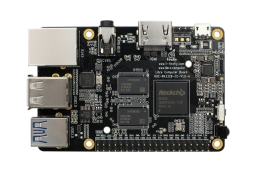NixOS on ARM/Libre Computer ROC-RK3328-CC
| Libre Computer ROC-RK3328-CC | |
|---|---|

| |
| Manufacturer | Firefly for Libre Computer |
| Architecture | AArch64 |
| Bootloader | Upstream U-Boot |
| Boot options | microSD, eMMC, SPI NOR Flash |
The ROC-RK3328-CC (Renegade) is a single board computer built around the Rockchip RK3328 SoC. It is very similar to the ROCK64.
There are three models of the board, with 1, 2 or 4 GB of RAM. It can boot from an microSD card or an eMMC. It also has a 128 Mbit SPI flash that can be used to store the bootloader.
Status
This board has upstream U-Boot and kernel support, although the mainline kernel may still be missing some features. NixOS can be installed using manual partitioning and nixos-install or by modifying the aarch64 installation image as described in the next section.
U-Boot for this board is packaged in nixpkgs, and Hydra builds can be found here:
https://hydra.nixos.org/job/nixpkgs/trunk/ubootRock64.aarch64-linux
This bootloader is not entirely open, incorporating a binary blob for the tertiary program loader (TPL). If your have nix installed you can download the latest version with (This command also works on different architectures since it can be downloaded from the binary cache):
$ nix-build '<nixpkgs>' -A ubootRock64 --argstr system aarch64-linux
$ ls -la result
-r--r--r-- 2 root root 107683 Jan 1 1970 idbloader.img
dr-xr-xr-x 1 root root 40 Jan 1 1970 nix-support
-r--r--r-- 2 root root 789504 Jan 1 1970 u-boot.itb
Board-specific installation notes
U-Boot needs to be copied to specific sectors on the microSD card, eMMC or image with dd.
You can use nixos-aarch64-images to get an rock64 compatible disk image or running the commands manually.
Download/build U-Boot for the board, and write idbloader.img and u-boot.itb.
Replace in the command below /dev/mmcblkX with the correct device to the sdcard i.e. /dev/mmcblk0. You can use the lsblk command to get a list of all devices:
dd if=idbloader.img of=/dev/mmcblkX conv=fsync,notrunc bs=512 seek=64
dd if=u-boot.itb of=/dev/mmcblkX conv=fsync,notrunc bs=512 seek=16384
This will make the first partition of the installation device unmountable and it can be deleted, but the space needs to be kept to not overwrite the bootloader with another filesystem.
Build your own image natively
You can customize image by using the following snippet.
# save as sd-image.nix somewhere
{ ... }: {
# only needed for crosscompilation
nixpkgs.crossSystem = lib.systems.elaborate lib.systems.examples.aarch64-multiplatform;
imports = [
<nixpkgs/nixos/modules/installer/sd-card/sd-image-aarch64.nix>
];
nixpkgs.config.allowUnfree = true; # needed for ubootRock64
# at the time of writing the u-boot version from FireFly hasn't been successfully ported yet
# so we use the one from Rock64
sdImage.postBuildCommands = with pkgs; ''
dd if=${ubootRock64}/idbloader.img of=$img conv=fsync,notrunc bs=512 seek=64
dd if=${ubootRock64}/u-boot.itb of=$img conv=fsync,notrunc bs=512 seek=16384
'';
# put your own configuration here, for example ssh keys:
users.extraUsers.root.openssh.authorizedKeys.keys = [
"ssh-ed25519 AAAAC3NzaC1lZDI1.... username@tld"
];
}
Then build with:
$ nix-build '<nixpkgs/nixos>' \
-A config.system.build.sdImage \
-I nixpkgs=https://github.com/NixOS/nixpkgs/archive/9bc841f.tar.gz \ # pinned to nixos-unstable on 2022-03-23
-I nixos-config=./sd-image.nix
USB
To enable USB power GPIO1_D2 must be pulled high. D2 translates to 26 (D=4, 4*8+2=26). Normally this is configured in the device tree, which gets loaded at boot time. At the time of writing, the ROC-RK3328-CC version of u-boot hasn't been ported to nixpkgs yet, so this is most easily done with the following systemd service.
systemd.services."usb-enable" = {
enable = true;
script = "${pkgs.libgpiod}/bin/gpioset 1 26=1";
wantedBy = [ "default.target" ];
};
Serial console
The ROC-RK3328-CC uses a GPIO pinout compatible with the Raspberry Pi 2 and newer. This means that the following pins can be used to connect a serial adapter:
| Pi-2 Bus | |
|---|---|
| Pin | Function |
| 6 | GND |
| 8 | UART0_TX |
| 10 | UART0_RX |
The serial console runs at 1500000 baud in the bootloader. When using the standard NixOS aarch64 sd image, set console=tty1 console=ttyS2,1500000n8 as kernel option in extlinux/extlinux.conf on the boot partition of the sdimage to get a serial linux console (tty1 is for standard HDMI output and ttyS2 is for the serial, baud rate setting is optional, simple console=ttyS2 seems to be working fine too). For debugging, console=uart8250,mmio32,0xff130000 should give you an early UART console, before the full serial console is up.
From the host computer run (update /dev/ttyUSB0 with your USB-to-serial device)
nix-shell -p python3Packages.pyserial --run 'python3 -m serial.tools.miniterm --exit-char 24 --raw /dev/ttyUSB0 1500000'
Compatibility notes
| Mainline kernel | ||
|---|---|---|
| Ethernet | Works | |
| USB | As of 5.4, USB 3.0 does not work | |
| HDMI | Video works, Sound does not | - |